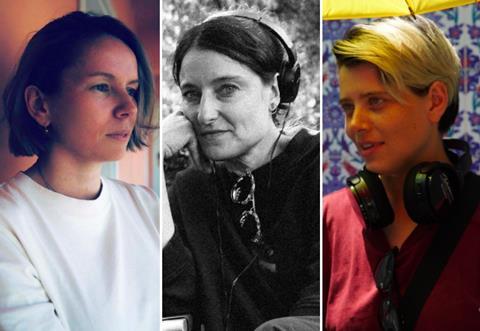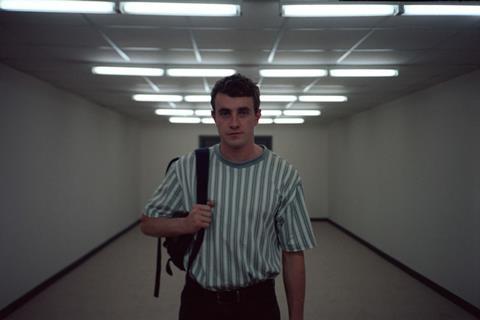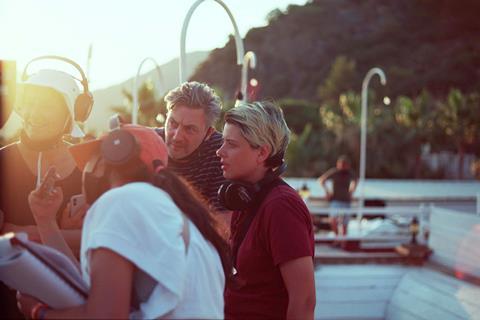Aftersun is a debut feature from a Scottish indie filmmaker that is making a big splash this awards season. Writer/director Charlotte Wells and lead producers Adele Romanski and Amy Jackson tell Screen about the film’s remarkable journey.

’Collaboration’ and ‘space’. These two words crop up repeatedly when tracing the creation of Aftersun, the debut feature of New York-based Scottish filmmaker Charlotte Wells. Essential to Wells’ personal ethos, the terms moved the film from a lo-fi personal story, to one of the most talked-about independent films of recent years.
Released in late October in the US through A24 and in November in the UK and Ireland through Mubi, Aftersun depicts young father Calum and his 11-year-old daughter Sophie on a 1990s package holiday, told via the memories of the now-adult daughter. Having received 16 British Independent Film Awards (Bifa) nominations — the second-most ever for a single film, behind only Saint Maud — it won seven prizes including best British independent film and director; and has impressed across the pond too, winning Wells the Gotham Award for breakthrough director and earning five Independent Spirit nominations.
Aftersun’s first key partnership began in 2017, when Wells was on New York University’s dual MBA‑MFA producing programme. “Colleagues in classes above were already well-situated in the industry,” she recalls. One student shared Wells’ short Laps with a friend, which led to meeting producer Adele Romanski, one third of US firm Pastel alongside Barry Jenkins and Mark Ceryak.
Despite being mid-shoot on Jenkins’ If Beale Street Could Talk, Romanski’s eye was drawn by the promise of Wells’ shorts. “Creatively, it felt like the kind of voice we at Pastel are interested in supporting,” she says. “Artists who make movies that we want to watch too.”
Wells took her time to bring up Aftersun with Romanski. “At a certain point, I admitted I was working on something,” she explains. “By then, we’d met for coffees and brunches and built up a relationship. So when it came to that terrifying moment of putting your trust in somebody new, there’s a foundation to work from. They were the first people I shared the script with.”
“It’s hard to move from the shorts to feature space,” acknowledges Romanski. “You could see very clearly how Aftersun was going to be a continuation of [Wells’] voice. Even if the script had been a mess, we would have pursued it. We never expect anybody’s going to stick that landing out of the gate. But she came really close. So, we just continued to refine that draft until it was ready to go to production.”
In 2020, Wells emerged from the Sundance Institute writing lab “not knowing which way is up — which is the purpose of that lab, and then you rediscover it”. She “cold-called” another key partner — then-BBC Film commissioning executive Eva Yates, now director of BBC Film. The UK broadcaster’s film arm had just worked with Pastel on Eliza Hittman’s Never Rarely Sometimes Always, so a renewal of the partnership made sense.
Yates was a solid backer — not just of the film, but also of Wells. “I sat down with Eva before shooting, and she said, ‘You always have such a clear idea of what this is. Go forth, and go for it,’” remembers Wells. Yates connected Wells and Romanski with producer Amy Jackson, a fellow Scot.
“When lockdown was happening, Adele got in touch and said, ‘There’s this film we’re going to push for next year,’” says Jackson. “I remember thinking the Aftersun script was quite different — very nostalgic. It gave a lot of space for the characters. I said, ‘If you guys want me in, I’m in.’” Jackson then secured further investment by taking the project to the BFI and Creative Scotland.

Patience rewarded
For casting, Romanski leant on Pastel’s experience of selecting unknown actors for Jenkins’ Oscar-winning Moonlight. “We knew Sophie would be a discovery, by the nature of the role being a child,” says Romanski. “We were able to give it the long runway it needed, to have the space to search, and find. So much of casting for those discovery roles is about patience and not falling into a rush job of having to find somebody quickly, to meet a shoot date.”
The pandemic extended the process, giving casting director Lucy Pardee space for a “mass outreach” to get people to submit videos for the roles of Sophie and the other children she meets at the resort. “Lucy and Charlie then had an epic task of combing through that material, and Adele and I would chip in as we narrowed down those lists,” says Jackson. In-person casting sessions followed in December 2020 in Glasgow, from which newcomer Frankie Corio “really stood out”.
The director sent Corio 1990s playlists to create a vibe. “But Frankie was not interested,” laughs Wells. “She loves the music that she listens to. She allowed herself to be immersed in the world of the film, that happened to be the world of the ’90s.” The actress could mirror Sophie’s interest in her father’s video camera, for different reasons. “[Frankie] had a real curiosity in the camera, coming from the opposite point of view,” says Wells. “Rather than it being a novelty because you’ve never seen this before, it’s a novelty because it’s such a primitive version of what you’re used to every day.”
Casting Calum posed its own problems. “Sophie is at this precipice between childhood and adolescence; what was less clear to me is that Calum is also at this tipping point,” says Wells. The solution was “to cast down [in age] a bit. Either you’re looking at a 30-year-old who is exactly what you’ve written — someone who looks extraordinarily young — or you just cast down [in age].”
When Irish actor Paul Mescal — now 26, but then aged 24 — was suggested, “there was definitely a second when I thought, ‘Is he too young?’” says Wells. “There is a big difference between 25 and 30 in terms of growing up; Paul had what was most essential for the feeling of the character.” Mescal achieved broad attention that summer for his debut role in BBC drama Normal People, in which his character begins as a teenager at school. “It was nice to play with an audience’s expectation of Paul,” says Wells, although she notes the major factor was whether the actor “could feel like a parent”.
“If you wanted to cast someone who’s going to help you on a financial basis, names start popping up at 30,” notes Jackson. “I was able to look at Paul singularly inside of this one role,” adds Romanski. “I tend not to let other noise into the conversation.”
In July and August 2021, Aftersun shot on location in the Turkish beach resort of Oludeniz, a town catering to UK tourism that had been closed the previous summer season due to the pandemic. “They opened for us on the day we arrived — one hotel, so that we could sleep that night,” recalls Romanski. “They were still filling the pool with water. The first few days, the beach was empty. By the time we’re wrapping the movie at the end of summer, it’s full of people.”
For Wells, while production “felt like a level up” from her shorts, “you’re still dealing with 10 people on a regular basis. It still felt intimate.” Romanski and Jackson were the on-set producers for the shoot, with Jenkins and Ceryak supporting from the US. “Barry’s been an unbelievable resource and advocate throughout this whole process, from casting tapes to cuts and standing on stage introducing the film,” says Wells.

Feeling the pressure
A climactic scene sees Calum dance to Queen and David Bowie’s ‘Under Pressure’, as Sophie’s holiday memories fuse with her adult mind among flashing lights. “We shot it under a real strobe — they’re uncontrollable,” says Wells. “Our film camera went out of sync with the light, so we were left with a single image, then eight-to-15 seconds of nothing, then a single image. I ended up spending five days just removing black frames so we had control over the pacing.” This led to a reshoot using an LED soft light instead of a strobe, “to give ourselves more footage to work with”.
However, “we executed that so well there was too much information,” says Wells. “The raw expression of feeling that we miraculously captured in that original shoot felt lost.” The final version is “mostly the original footage”, with elements from the reshoot in the closing moments. “What we captured in that reshoot was absolutely worth it to create the fullness of that final scene.”
Romanski recalls an initial rough cut that was an hour longer than the final film, in which she knew they had a strong feature. “I could see we were going to have to do a bunch of work; then it gets to that final scene. Even though I’d read the script 100 times, I’d seen all the dailies, I was on set for every scene — it knocked me out. I was wrecked. I was sat on my couch and just thought, ‘Okay, we have the movie. Now we have to do the work.’”
The edit was where Wells noticed the biggest divergence from her shorts work. “It blew me away how much stamina was required to push through nine months of working on the same project,” she says of her collaboration with Blair McClendon, who won the best editing Bifa. “Most of the time was spent with us looking at scenes on the wall, discussing what should be in or out, and what it meant for one sequence to follow another. There was a lot more talking than typing.”
The team had set an April 2022 deadline to lock the film, with Cannes in May as the ideal launchpad. Discussions around distributor partners remained deliberately low-key. “We didn’t want a lot of attention,” says Jackson. “We wanted it to be a space where Charlie felt like she could make what she wanted.” When the film was finally announced, Jackson recalls overhearing discussion that “Paul Mescal is in something and we don’t know about it. That felt like a coup,” she smiles.
Mubi flagged up interest a week out from Cannes, picking up the film for multiple territories including UK-Ireland, France and Germany, before the film made its bow in the Critics’ Week section on May 21. Days later, A24 boarded the film for North America — a natural partner, as the company already had a first-look TV deal with Pastel.
Subsequent festival slots included Edinburgh, Melbourne and Telluride — where Wells last watched the film. She is now aiming for distance, as she continues to promote Aftersun around the world. “I had a really nice viewing of it [in Telluride],” she says. “It’s hard to imagine watching it again anytime soon. I follow its reception, [but] it doesn’t change how I feel about the film.”
Speaking to Screen International after the Bifa nominations had been announced but ahead of the ceremony, Wells says the recognition has brought “a lot of pride that so many heads of department got nominated. Collaboration is one of the most essential parts of this.”
Wells is taking the same ethos into future work. “I’m not in a rush. For me, this is about expression, it’s not about making another film. It’s about having something to say and using film to say it. I need that headspace to find my way to it — I want to create that space for myself. It’s important to protect that.”






![The Brightest SunScreen[Courtesy HKIFF]](https://d1nslcd7m2225b.cloudfront.net/Pictures/274x183/3/5/0/1448350_thebrightestsunscreencourtesyhkiff_312678.jpg)


















No comments yet